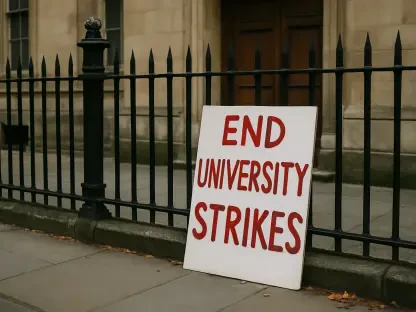In a striking development that has sent shockwaves through the higher education landscape, a major antitrust lawsuit has been filed against 32 prestigious U.S. colleges, alongside application platforms like Common App and Scoir, and the Consortium on Financing Higher Education (CFHE). This legal challenge, brought to light on a recent Friday, accuses these entities of leveraging early decision admissions to suppress competition, inflate tuition prices, and restrict financial aid options for countless students. The allegations paint a troubling picture of a system where elite institutions prioritize revenue over fairness, potentially impacting tens of thousands of applicants. As the case unfolds, it raises profound questions about the ethics of admissions practices and whether they serve to widen the gap between socioeconomic classes, leaving many to wonder if the pursuit of a top-tier education comes at an unjust cost.
Unpacking the Antitrust Allegations
Early Decision as a Mechanism for Market Control
The crux of the lawsuit centers on the claim that early decision admissions allow elite colleges to manipulate market dynamics in their favor, reducing competitive pressure to offer attractive financial aid packages. Unlike regular decision processes, where students can evaluate and compare aid offers from multiple institutions before committing, early decision binds applicants to a single school before they even know the financial terms. This setup, as argued by the plaintiffs, enables colleges to strategically minimize aid expenditures, secure enrollment numbers early, and avoid the risk of losing students to competitors with better offers. The practice essentially locks students into a decision without the leverage to negotiate or seek better options, creating a one-sided power dynamic that benefits institutions at the expense of applicants who may struggle with the resulting costs.
Further examination reveals how this admissions strategy serves as a calculated move to bolster institutional stability. By filling a significant portion of their incoming class through early decision, colleges can predict enrollment yields with greater accuracy, reducing uncertainty in their planning. This predictability, however, comes at a steep price for students, who are often left with limited recourse if the financial aid package falls short of their needs. The lawsuit suggests that this isn’t merely a byproduct of the system but a deliberate tactic to prioritize fiscal goals over student welfare. As such, the process undermines the competitive nature of higher education, where institutions should, in theory, vie for talent by offering the most compelling support, not by restricting choice through binding commitments.
Misleading Perceptions of Commitment
Another critical allegation in the lawsuit focuses on the widespread misconception that early decision agreements carry legal weight, a belief that significantly influences student behavior. Colleges often present these commitments as binding, requiring signatures from parents or counselors and implying that students can only be released under extreme financial hardship. Yet, the reality, as highlighted in the legal filings, is that these agreements are not enforceable in a court of law. Despite this, the perception of obligation intimidates many applicants into accepting offers, even when the financial aid provided is inadequate, resulting in higher out-of-pocket expenses for families who feel they have no alternative but to comply with the terms set forth.
This misunderstanding is not merely a student oversight but, according to the lawsuit, a calculated tool exploited by institutions. Administrators are aware that the aura of legal obligation discourages students from challenging insufficient aid packages or seeking release from their commitment. The result is a chilling effect on negotiation, where applicants accept terms under duress, believing they are bound by a contract that holds no true legal standing. This dynamic disproportionately burdens those who lack the resources or guidance to navigate the complexities of admissions policies, further entrenching a system where misinformation serves institutional interests over student empowerment and choice.
Socioeconomic Impacts and Systemic Issues
Disadvantage for Lower-Income Students
Delving into the socioeconomic ramifications, the lawsuit underscores how early decision admissions disproportionately favor wealthier students, creating a stark barrier for those from lower-income backgrounds. Affluent applicants can commit to a college without concern for the financial aid outcome, confident in their ability to cover costs regardless of the package offered. In contrast, students who rely on substantial aid are placed at a severe disadvantage, unable to compare offers from multiple schools and often forced to accept whatever is provided, even if it means significant financial strain. This disparity effectively turns early decision into a mechanism that prioritizes access for the privileged, sidelining those who most need support to achieve a higher education.
Compounding this issue is the disparity in acceptance rates, as evidenced by historical data referenced in the lawsuit. For instance, Brown University’s admissions figures from a past cycle showed that early decision applicants were accepted at a rate of 18%, compared to just 4% for regular decision candidates. Such statistics suggest that the process inherently tilts toward those who can afford to apply early without financial hesitation, often correlating with socioeconomic status. Critics argue this creates a form of affirmative action for the affluent, perpetuating inequality by design. The inability to shop around for better aid packages means that lower-income students are frequently locked into less favorable financial situations, deepening the divide in access to elite education.
Role of Application Platforms and Coalitions
The lawsuit extends beyond individual colleges, pointing to systemic collaboration through entities like Common App, Scoir, and CFHE as key enablers of early decision practices. These platforms and coalitions are accused of enforcing rules that restrict students to a single early decision application, effectively limiting their options from the outset. Additionally, by removing accepted early decision students from other colleges’ applicant pools, these systems ensure that institutions face less competition for talent, reinforcing the binding nature of the process. CFHE, a group of selective liberal arts colleges, is further implicated for allegedly sharing information that solidifies these practices, creating a coordinated effort to maintain market control across the sector.
Moreover, the influence of these collaborative entities extends to colleges that don’t even employ early decision, such as MIT, which are said to indirectly benefit from the market trends set by their peers. By adhering to rules established through these platforms and adjusting tuition in response to benchmarks set by early decision schools, non-participating institutions still reap advantages from a system skewed toward higher costs and reduced aid competition. This interconnected web of influence, as outlined in the legal challenge, suggests that reforming admissions practices will require addressing not just individual college policies but the broader infrastructure that upholds and perpetuates these inequities across higher education.
Broader Effects on Higher Education
Tuition Inflation and Institutional Reluctance
A significant ripple effect of early decision, as detailed in the lawsuit, is its contribution to escalating tuition costs throughout the higher education landscape. Colleges that utilize this admissions strategy often set higher price points, knowing that committed students are less likely to balk at the cost due to their binding agreement. This trend establishes a benchmark that allows other institutions, even those not using early decision, to increase their own tuition rates while remaining competitive in the market. The result is a pervasive cycle of inflation, where the cost of attending college continues to climb, placing an ever-growing burden on students and families who are already grappling with affordability challenges in pursuit of quality education.
Equally troubling is the reluctance of colleges to abandon early decision, despite mounting criticism and evidence of its harms. Institutions fear that stepping away from the practice could lead to a loss of tuition revenue and high-caliber students to competitors who continue to leverage it. This competitive bind creates a self-perpetuating system where even schools that recognize the inequities are hesitant to act unilaterally, worried about the immediate financial and reputational impacts. The lawsuit argues that this inertia sustains an unfair status quo, prioritizing institutional interests over the broader goal of equitable access. Until external pressure or legal outcomes force a shift, the cycle of rising costs and restricted aid options is likely to persist, further challenging the affordability of elite education.
Legal Implications and Future Pathways
Reflecting on the legal action taken, the lawsuit against these 32 elite colleges and associated entities marks a pivotal moment in challenging the entrenched practices of early decision admissions. The plaintiffs, representing current and former students from various prestigious schools, seek not only damages for past harms but also a permanent injunction to halt the use of early decision, alongside class action status for tens of thousands affected over several years. This bold move spotlights a core strategy among top-tier institutions, exposing how deeply embedded the practice has become in shaping admissions and financial policies at the highest levels of academia.
Looking ahead, the implications of this case demand serious consideration by all stakeholders in higher education. If successful, the push for a ban on early decision could compel colleges to rethink enrollment strategies, potentially fostering greater competition and generosity in financial aid offerings. Even if the legal outcome falls short, the public discourse it sparks offers a chance to pressure institutions toward voluntary reform. Policymakers, educators, and families alike are encouraged to advocate for transparent admissions processes that prioritize fairness, ensuring that access to elite education no longer hinges on socioeconomic advantage but on merit and opportunity for all.









